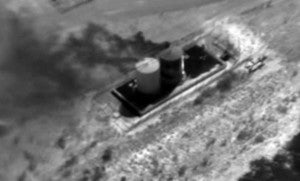What’s new for the EPA’s Greenhouse Gas Reporting Program?
 This week, the U.S. Environmental Protection Agency posted the 2016 Greenhouse Gas Reporting Program (GHGRP) data online. While there are positive trends in the type of data included and the ways that data are measured, the general picture is of an industry with many remaining opportunities to reduce emissions.
This week, the U.S. Environmental Protection Agency posted the 2016 Greenhouse Gas Reporting Program (GHGRP) data online. While there are positive trends in the type of data included and the ways that data are measured, the general picture is of an industry with many remaining opportunities to reduce emissions.
The GHGRP is an emissions reporting program for large facilities that emit more than 25,000 metric tons carbon dioxide equivalents (MT CO2e) of methane and other greenhouse gases into the atmosphere. The data provided by the GHGRP are invaluable for understanding the sectors and sources responsible for GHG emissions and can guide the design of effective policies for reducing emissions.
Additionally, EPA has been incorporating GHGRP data into the Greenhouse Gas Inventory, an annual report that estimates U.S. GHG emissions. In 2016, 7,631 facilities reported emitting almost 3 billion MT CO2e GHGs. After power plants, which are responsible for 63% of reported emissions, the oil and gas (O&G) sector is the largest source of GHG emissions. This year there are three major changes to the reporting protocols for oil and gas facilities.
Onshore production facilities now identify individual wells
Onshore production facilities are defined by the GHGRP as all of an operator’s well pads in a geologic basin. This made it difficult to match up GHGRP data to individual wells, especially since companies are constantly acquiring, divesting, drilling, and shutting in wells. Starting this year, onshore production facilities must include a list of individual wells identified by unique API identification numbers. This will make it much easier to link and compare GHGRP data with other data sources like Drillinginfo. Inclusion of the API well numbers is a great step for increasing the transparency and value of the reporting program data. For example, we now know that 450,000 wells, about half the U.S. population, report emissions to the GHGRP.
Transmission pipeline facilities report emissions for the first time
When compressor stations and pipelines require maintenance, it is often necessary to remove pressurized natural gas from equipment for safety reasons; this gas is often vented to the atmosphere as a “blowdown”. Previously, transmission stations had to report blowdown emissions if they vented from within the station fence line, but not the pipeline between stations. Transmission pipelines are now considered separate facilities from the stations and operators must report blowdown emissions if they exceed the reporting threshold. In 2016, 26 transmission pipeline facilities reported emissions from over 9,000 blowdowns. Astonishingly, these blowdown emissions were greater than the entire reported emissions from transmission stations. This indicates the importance of implementing mitigation actions for capturing or preventing pipeline blowdown emissions, such as lowering gas line pressure before maintenance.
Gathering and boosting facilities report emissions for the first time
Gathering and boosting facilities are a network of pipelines and compressor stations that collect gas from multiple wells and transport it to processing plants or transmission pipelines. For the GHGRP, gathering and boosting facilities are defined as all of a company’s gathering pipelines and stations in a geologic basin. Initially excluded from the GHGRP, there were 299 gathering and boosting facilities reporting almost one million metric tons of methane emissions in 2016, or 25% of the total reported methane emissions from the O&G sector. It is no surprise that gathering emissions are large: the CSU/EDF gathering and processing study estimated that the entire U.S. gathering sector emits 1.9 million metric tons of methane. The three biggest emission sources – storage tanks, equipment leaks, and pneumatic devices – account for 75% of reported emissions. Luckily, there are proven mitigation options for these sources that can help reduce emissions from this important sector.
EPA continues to make progress on the Greenhouse Gas Reporting Program
The change in reporting protocols, including the new addition of gathering and transmission pipeline facilities, complicates a year-to-year comparison of the data. From 2015 to 2016, reported oil and gas methane emissions increased 37% from 2.8 to 3.8 million metric tons CH4, but this increase was mainly caused by the addition of these new sources. If you exclude these sources, there has only been a 3% decrease in O&G methane emissions – the biggest reductions have been from liquids unloading and associated gas venting and flaring. Given that oil and gas liquids production has decreased by 6% in the same time period, we would hope that emissions would decrease at least a similar rate. Although some companies have made progress reducing emissions, the industry as whole needs to increase their efforts at mitigating methane emissions.
The most recent release of data reflect helpful updates to the data from the oil and natural gas sector, and we encourage EPA to continue to make changes to increase the accuracy of its reporting protocols, such as requiring greater use of direct measurements instead of emission factors.











